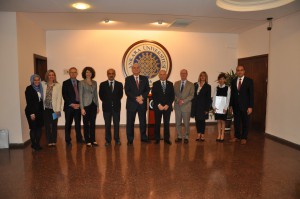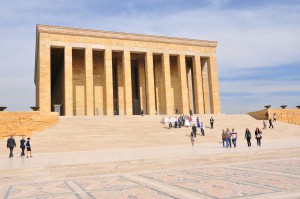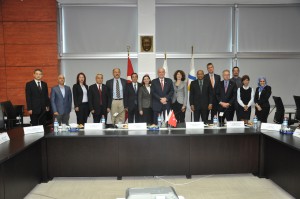Ankara: A uniquely intellectual city
The more you drive around Ankara, the more you begin to fully appreciate the vastness and vibrancy of Turkey’s capital and second-largest city.
Although Ankara, with its barren hills, bright lights and modern-style skyscrapers, offers a dramatically different cityscape architecturally and geographically from Istanbul’s historic peninsula, it possesses its own distinctive energy that is equally emblematic of modern-day Turkey and its goals for the future.
The home of state government and—with its strategic location at the center of Turkey’s highway and railway networks—an important crossroads of commerce, Ankara is a uniquely intellectual city, a fact further evidenced by the numerous colleges and universities that operate here. Those institutions, including two impressive schools (one public, one private) with which members of the IU delegation met today, are increasingly driving the development of highly trained human capital in Turkey in order to help this historic and strategically important nation fully realize its economic potential in the 21st century.
A proud partner
Friday morning delivered the delegation to Ankara University, which was founded in 1946 as the first higher education institution of the Turkish Republic, under the country’s legendary first president, Mustafa Kemal Atatürk. Ankara’s buildings reflect a German architectural style, the direct result of numerous Jewish architects finding a safe home at the university after World War II. (As IU Vice President David Zaret noted, many successful IU programs were constructed during this same time, when IU’s legendary 11th president Herman B Wells offered similar sanctuary in Bloomington to many of Europe’s finest young artists, musicians and scholars.)
Despite its relative youth, Ankara is steeped in tradition. Many of its schools (called faculties in Turkey), including law, agriculture, humanities, medicine and political science, were established decades before the university’s inception. What’s more, the symbol of this modern university is a sun disc, belonging to the ancient Hittite civilization, which reached its height during the mid-14th century BC when it ruled most of Asia Minor. This bronze symbol, believed to have been developed 300 years prior to the Hittite settlement in Anatolia, was most commonly used more than 4,000 years ago in religious ceremonies.
Today, Ankara boasts a total enrollment of 60,000 students and 3,500 academic staff, and it serves as a key partner for IU’s Turkish Flagship Center, the only federally funded center of its kind in the U.S., in providing IU students with opportunities to travel here to study Turkish and live with host families. Two IU students studied at Ankara last year, and two more students are currently in residence.
The university’s primary institutional partner at Ankara is TOMER, the Center for Applied Turkish and Foreign Languages Research, which has 11 branches across Turkey. Founded 30 years ago, TOMER has periodically delivered Turkish instructors to IU, one of its select few U.S. partners, for short-term educational programs, and it has set its sights, just like IU, on strengthening the global proficiency of its students by exposing them to study abroad activities at the world’s best universities.
To this end, representatives from both IU and Ankara agreed that the Turkish Flagship Center-TOMER partnership might point the way to future quality collaboration.
Sharing IU’s standpoint, Zaret said, “We are immensely proud of our flagship program, and we hope to see even more of our students take advantage of the opportunities made possible through our strong partnership.”
An awe-inspiring detour
After visiting Ankara University, it was only fitting that the delegation use what few spare minutes it had before its next series of meetings to make a quick, unscheduled detour to Anitkabir, the mausoleum of Mustafa Kemal Atatürk.
Adorned with remarkably detailed marble columns, statues and sculptures, and 10 towers situated in a symmetrical arrangement, Anitkabir, which literally means “memorial tomb,” was designed to reflect the ideals that influenced Turkish independence and the creation of the Turkish Republic.
Walking the Road of Lions to the massive Ceremonial Plaza, which offered a simply stunning view of the city, and finally into the Hall of Honor, the location of Atatürk’s tomb, with its astonishing pyramidal ceiling lined with gold mosaics, it was impossible not to be awestruck by one of Turkey’s most impressive engineering feats and the most striking symbol we’d yet witnessed of the contemporary Turkey in which IU seeks to become increasingly engaged in the years to come.
Meeting the demand for higher education
Finally, it was on to the TOBB University of Economics and Technology, the first private university the IU delegation has visited on this weeklong trip, and Turkey’s first university to offer cooperative education that combines classroom education with practical business experience.
Only 10 years old, TOBB is already playing a major role in addressing an enormous demand for higher education in Turkey, where around half of the population is under 25 years of age.
To meet this demand, TOBB has quickly established six undergraduate schools (in engineering, economics, science and literature, art and design, law and medicine) and two grad schools (natural and applied sciences, social sciences), plus a technical center that opened just last year and includes more than 100 research and education laboratories.
Beginning their sophomore year, TOBB students are placed in companies and institutions to complete three years of practical training. The university counts among its connections and supporters around 2,000 businesses and industries.
As TOBB seeks ways to continue its rapid growth, its representatives were especially interested to hear about IU’s considerable and longstanding strengths in business, the medical and life sciences, and foreign language instruction. (As IU President Michael McRobbie is fond of noting, among U.S. colleges and universities, IU teaches the most foreign languages, between 70-80 in any given year.) Additionally, as TOBB looks to become more plugged into promising growth areas around the world, its leading faculty were pleased to hear McRobbie describe Indiana’s strong pro-business climate and particularly vibrant health and life sciences sector.
Those representatives included Janamitra “Dev” Devan, who currently serves as a strategic advisor to TOBB President M. Rifat Hisarcıklıoğlu, as well as senior advisor to the chair of the Turkish B20 and to TEPAV, Turkey’s premier think tank.
Dev, who formerly served as vice president and head of network of the World Bank Group where he managed a $10 billion portfolio, received his Ph.D. in business economics and international business from IU’s Kelley School of Business.
In addition to his educational training, Dev clearly picked up, during his time in Bloomington, a personal recognition of IU’s many and diverse strengths as a leader in education, research and international engagement.
“It’s almost intimidating what IU has,” he said.
None of us could’ve said it better on a day in which we all acquired a much greater understanding of both the challenges and opportunities facing this fascinating city and country.
Tags: Anitkabir, Ankara, Ankara University, Center for Applied Turkish and Foreign Languages Research, David Zaret, Hittite, IU Turkish Flagship Center, Janamitra "Dev" Devan, M. Rifat Hisarcıklıoğlu, Michael A. McRobbie, Mustafa Kemal Atatürk, TOBB University of Economics and Technology, TOMER, Turkey






